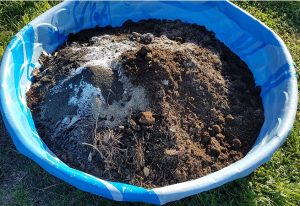 Every good gardener who’s been at it awhile, knows that success starts in your garden’s soil.
Every good gardener who’s been at it awhile, knows that success starts in your garden’s soil.What’s the difference between soil and dirt?
Dirt and soil seem like interchangeable terms, but really they’re not.
Soil has living matter in it–microbes, earthworms, nematodes, and other organisms that indicate the “dirt” is not just parched, dead matter.
So how do you change dirt into soil?
We did this in our large peach orchard area, which previously had really awful, light-colored dirt….and now, four years later, you can dig down quite deep and still have nothing in your hands but rich, black soil.
Incidentally, new research shows that the soil microbes die en masse whenever the soil is disturbed, so it’s actually better NOT to till.
But what if you just want a soil mix for raised beds?
What if you’re lousy about remembering to water, or live in a dry area?
For raised beds, we use a mixture of peat moss, natural soil amendments, and compost. It’s far from perfect, but this recipe is working really well in our Texas garden so far. This is the second year we’ve used it.
How to make a “superfood” low-water soil mix for your raised bed garden:

First, set up a kiddie pool near your compost pile (or bags, or bins, etc).
>> Make sure it’s in an area where you can use a wheelbarrow, and easily move it between here and your garden area. (This is important for later).
Now, get one cube of compressed peat moss. They’re usually about $10, and 60-70 kbs.
>> Add enough water to the kiddie pool to get the peat moss evenly wet, and let it soak overnight.
Peat moss comes compressed, and it can hold a LOT of water. That’s why it’s a great choice for areas that get a lot of heat and sunshine.
The next day, check on the soaked peat moss, and add more water if it seems dry!
Then, add the following amendments to the kiddie pool and mix well with a shovel:
- 1-4 cups of Azomite (trace minerals, also called rock dust)
- 2-8 cups worm castings (or more, if you have it!)
- 1 cup silica amendment (why?)
- 1 tsp mycorrhizae
This year, we added a super-secret ingredient to the mix–bat guano!
Bat guano is about the most concentrated source of nitrogen and minerals you can find. And yes, climbing into a cave WAS involved in obtaining this ingredient!
Bat guano is whitish, extremely dense, and heavy–so a little goes a long way.
We added about 1/2 of a cup of bat guano to an old bucket, added water from the hose, and swirled it around until we had a thick, milky substance to add to the peat moss mixture.

Now you’re ready to fill your raised beds!
Get your wheelbarrow, and start shovelling until it’s full. Add 1 shovel of the mix from the kiddie pool, for every 2 shovels of compost.

>> You want 1/3 of the total bed volume as amended peat moss, and 2/3rds of the bed, pure compost.
Once your wheelbarrow is near full, mix it up a bit, and you’re ready to add it to your raised beds.
We have found this mix to grow hardy plants that thrive, even without watering much, and through the Texas summer heat.
If you want to achieve garden perfection, top-dress with your organic (free!) fertilizer of choice, and cover the surface with a mulch of 1-2 inches of hay.
Happy gardening!
Find the article on Steemit here.





